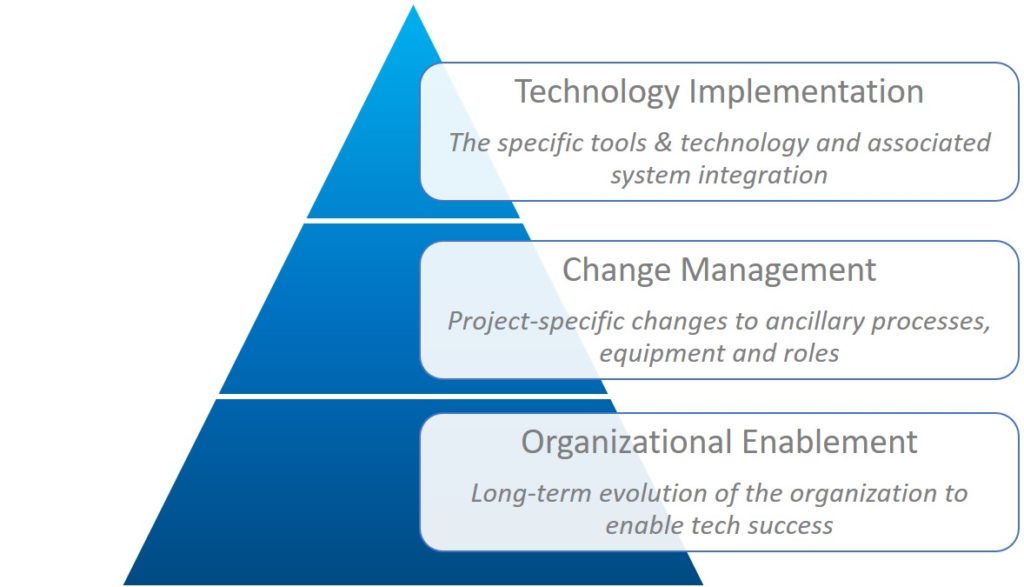
Fundamentals of OE #6: Take an Adaptive Approach to Technology
Summary:
- Technology can help achieve operational excellence, but it isn’t dependent on advanced your technology is
- Operational Excellence requires a holistic approach to technology where the objective is adapting to tech rather than simply adopting it
- This approach expands the focus from implementing new technology to the systemic issues impacting how well the organization prepares for and utilizes its tools
You can’t talk about operational excellence without addressing the approach. Its impact is so pervasive in every part of the business that it can’t be left as an afterthought. Furthermore, part of our definition for Operational Excellence is “delivering sustainable leading performance”. With how rapidly technology changes, a company cannot expect to sustain operational excellence without an effective way of keeping up with technology.
The key question is: how do Operationally Excellent companies differ in their approach to technology?
Before diving in, we should clarify our intent. When most people talk about OE and technology, they tend to focus on making the case for typical OE software solutions such as tools for performing risk assessment, tracking audits and incident investigations, or creating procedures. While there are hundreds of great tools out there that add value when properly utilized, the more pertinent discussion starts at a higher level. Before considering specific tools, OE begins with your company’s overall approach to effectively adapting to changing technology.
Going back to the question, there are definite differences in how OE companies approach technology. One would assume that OE companies typically are also high-tech, but this isn’t always the case. We’ve seen OE companies span most of the adoption spectrum, from early adopters to laggards. We’ve also seen many companies that are constantly adopting the latest tech and are nowhere near OE levels of performance. It doesn’t come down to how much technology they use, but rather how selective they are and how effectively they adapt to it.
How OE companies select what new technology to adopt
They start with the problem, not the product
Conversations about improving the business shouldn’t start with the solution, and this is especially true of technology for two reasons.
- The first is bias. Of all ideas that come across executives table, considerations for new technology are among the most susceptible to the Appeal to Novelty fallacy, meaning it is easy to favor it over the status-quo simply because it’s new and modern. When the conversation starts with the technology, the evaluation process tends to succumb easier to biases and inaccurate information.

- The second reason is that technology can offer deceiving promises and mask the real root causes. A very good example is collaboration-tool overload. The University of Virginia estimates that knowledge workers spend about 70-85% of their time dealing with meetings, email and other forms of collaboration, leaving them very little time to create value. Every collaboration tool claims to improve employee productivity, but over-collaboration is rarely made better by adding more technology. What we’ve seen instead is, as it has become easier and cheaper to collaborate, it hasn’t improved productivity. Instead of reducing the cost of collaborating with a small group of people on a project, it has encouraged collaboration with a much larger group. As some are beginning to realize, collaboration tools mask the true causes over-collaboration such as improper organizational design, unclear accountability and cultural barriers.
Technology is part of a larger discussion
Companies that effectively and repeatedly adapt to new technology start the evaluation long before considering any actual technology. They have an ongoing, honest discussion about the business needs and issues before considering potential solutions. Despite how elementary this seems, it’s much harder to get it right than it sounds. Many companies find these discussions rarely translate to or influence conversations about technology. This goes back to our Fundamental #1 about integrating disparate management systems. If conversations around the biggest risks to the business never translate to the conversations around technology, you are operating with separate management systems.
Getting this right requires gaining a clear understanding of the complex issues affecting your organization. Rather than starting with the symptoms, begin with a thorough evaluation of the root cause and the complexity of the issue. More advanced organizations use their ERM program to consolidate risks across the business, prioritize short and long-term objectives, and thus identify the tools needed to reach those objectives.
By using this approach, OE companies are in the driver seat. They are better able to identify what technology they need, even if it doesn’t exist yet and they need to be the ones to create it. It also allows them to have a broader picture of the issues and create a holistic solution to a complex problem
OE companies don’t adopt, they adapt
The second main difference for OE companies is how effectively they adapt to new technology. Here we should be clear – where many companies view new technology as an issue of adoption, OE companies view it as an adaptation challenge. When you adopt technology, the primary focus is adding that technology to the system. When you adapt to technology, the primary focus is changing the system, whether that requires additional technology or not.
To illustrate this point, we will look at the process as one which has three stages which all need to work in unison in order for any technology to deliver on its promise.
- Stage 1: Technology Implementation
- Stage 2: Change Management
- Stage 3: Organizational Enablement
The most basic stage is Technology Implementation, meaning the integration of the actual technology platform. This relates to how well the specific tool or technology is integrated within existing platforms, systems and data. The next stage is basic Change Management necessary to ensure proper communication, training and documentation for the new technology. Most companies do these first two, and they do them on a project-specific basis.
The third stage is where many companies fall short, the Organizational Enablement. This refers to the long-term evolution of the organization to enable successful integration of future technology, and includes far-reaching changes to the operating model, organizational capability and knowledge, and even cultural norms and biases. These are factors that impact the effectiveness of many separate technologies, but are too large of an undertaking to be included within the change management for most single tech projects. Organizational Enablement is not specific to any single technology, as efforts to enable the organization are difficult to justify in the ROI for a single project.
For example, training is a critical part of any new tool. That training would be much more effective if incorporated into the ongoing training program and something like a web-based LMS, especially if certification is involved. An LMS would be difficult to justify for a single piece of software, but aggregating the value of an LMS across multiple new platforms and skills makes it much easier to justify. More importantly, Organizational Enablement is treated as an ongoing effort that is reevaluated and adjusted as needed. Continuing with the training example, this allows insights from training specific to a previous piece of software to be used to make future training more effective.
Lastly, Organizational Enablement isn’t only about enabling future technology. Like a tide that raises all boats, it is used to improve the effectiveness of existing technology. For instance, going back to the issue of collaboration overload. Often, project teams use collaboration as a safeguard against the repercussions of making a mistake, as a sort of insurance. What if that team was given greater clarity around accountability and if the culture empowered people to make decisions? Project teams in organizations where this is the case are far more productive, even without the latest collaboration tools.
Operational Excellence requires having a long-term view of where your organization is going with regard to technology, and having a proactive way to set the environment for future technology to succeed.
Contact us today to find out how you can improve your organization’s ability to execute by improving the way it adapts to ever-changing technology.
Previous Post: “Fundamentals of OE #5: Keep it Simple”
Next Post: “Fundamentals of OE #7: Ownership & Accountability”
This post is an excerpt from the white paper “The Fundamentals for Transforming Your Organization Through Operational Excellence.” Download the complete white paper here.
Let’s Talk
We will help you overcome strategic challenges to realize the business value you seek.

Francisco Soto
Director
Francisco Soto is a thought leader in the operational excellence space. He specializes in simplifying how his clients maximize the value of their strategy through a combination of their integrated management system and culture. Francisco has extensive experience across an array of industries but…
